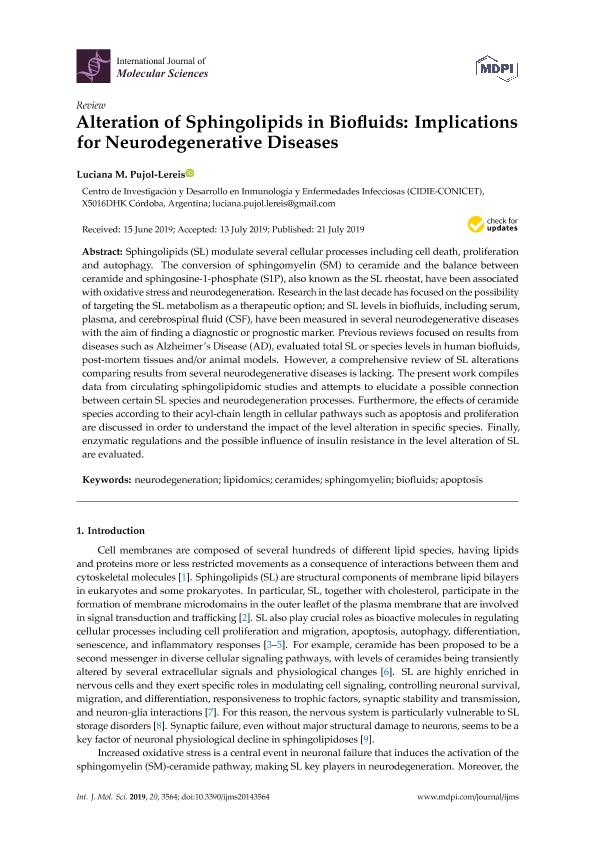Artículo
Alteration of sphingolipids in biofluids: Implications for neurodegenerative Diseases
Fecha de publicación:
21/07/2019
Editorial:
Multidisciplinary Digital Publishing Institute
Revista:
International Journal of Molecular Sciences
ISSN:
1422-0067
Idioma:
Inglés
Tipo de recurso:
Artículo publicado
Clasificación temática:
Resumen
Sphingolipids (SL) modulate several cellular processes including cell death, proliferation and autophagy. The conversion of sphingomyelin (SM) to ceramide and the balance between ceramide and sphingosine-1-phosphate (S1P), also known as the SL rheostat, have been associated with oxidative stress and neurodegeneration. Research in the last decade has focused on the possibility of targeting the SL metabolism as a therapeutic option; and SL levels in biofluids, including serum, plasma, and cerebrospinal fluid (CSF), have been measured in several neurodegenerative diseases with the aim of finding a diagnostic or prognostic marker. Previous reviews focused on results from diseases such as Alzheimer’s Disease (AD), evaluated total SL or species levels in human biofluids, post-mortem tissues and/or animal models. However, a comprehensive review of SL alterations comparing results from several neurodegenerative diseases is lacking. The present work compiles data from circulating sphingolipidomic studies and attempts to elucidate a possible connection between certain SL species and neurodegeneration processes. Furthermore, the effects of ceramide species according to their acyl-chain length in cellular pathways such as apoptosis and proliferation are discussed in order to understand the impact of the level alteration in specific species. Finally, enzymatic regulations and the possible influence of insulin resistance in the level alteration of SL are evaluated.
Palabras clave:
NEURODEGENERATION
,
LIPIDOMICS
,
CERAMIDES
,
SPHINGOMYELIN
,
BIOFLUIDS
,
APOPTOSIS
Archivos asociados
Licencia
Identificadores
Colecciones
Articulos(CIDIE)
Articulos de CENTRO DE INV. Y DESARROLLO EN INMUNOLOGIA Y ENFERMEDADES INFECCIOSAS
Articulos de CENTRO DE INV. Y DESARROLLO EN INMUNOLOGIA Y ENFERMEDADES INFECCIOSAS
Citación
Pujol Lereis, Luciana Mercedes; Alteration of sphingolipids in biofluids: Implications for neurodegenerative Diseases; Multidisciplinary Digital Publishing Institute; International Journal of Molecular Sciences; 20; 14; 21-7-2019; 1-20
Compartir
Altmétricas




